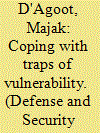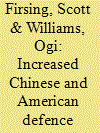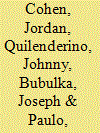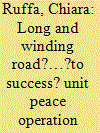|
|
|
Sort Order |
|
|
|
Items / Page
|
|
|
|
|
|
|
| Srl | Item |
| 1 |
ID:
121156


|
|
|
|
|
| Publication |
2013.
|
| Summary/Abstract |
As part of a bio-inspired design process, the authors examine exoskeletal sensors found in insects and their potential application to armor and hardened buildings. In this way, the outer hardening of a structure or vehicle would not limit the ability of occupants to arrive at an actionable picture of the outer environment. To this end, various sensor modalities employed by insects are compared and contrasted with their current human-engineered equivalents. In several sensing modalities, biosensors perform better, are smaller, and more energy efficient than human-engineered equivalents. They note that biological designs tend to employ non-linear response to signal amplitude and respond with heightened sensitivity over a greater dynamic range of signals than human-engineered sensors. The insect biological sensors have structural and mechanical innovations that preserve the protective capacity of the exoskeleton.
|
|
|
|
|
|
|
|
|
|
|
|
|
|
|
|
| 2 |
ID:
121152


|
|
|
|
|
| Publication |
2013.
|
| Summary/Abstract |
In a world virtually free of slavery and colonialism and one mainly driven by the sovereign state rationale, allusion to manifestations or the existence of some form of these phenomena within a state is often received with dumbfounding indifference or denial. However, a form of rule that had continued in South Sudan long after the departure of the British in 1956 was colonial both in its quintessence and flair in that it disenfranchised its citizens and denied them the most basic freedoms, services and development. Under this establishment, resistance against the coercive vision of the state was brutally suppressed for many decades. This state of affairs finally ended in July 2011. Nonetheless, there is a miscellany of unresolved post-colonial issues between the two countries that warrant attention. These include security and the demarcation of borders, the issue of ludicrous transit fees for South Sudan's oil exportation through Sudan, citizenship, external debt repayment, etc. These issues are part of traps inherited from the anti-colonial struggle, which have now supplanted the old ensemble of North-South conflict paroxysm. As a matter of urgency, the two countries will have to wrap up the incomplete process of negotiation on these substantive issues. The talks should be approached with a new mindset based on the new reality of two sovereign states. To the extent that it is widely established that South Sudan and Sudan must coexist peacefully in order to develop into viable entities, such mutual dependency must be based on equality and respect.
|
|
|
|
|
|
|
|
|
|
|
|
|
|
|
|
| 3 |
ID:
121153


|
|
|
|
|
| Publication |
2013.
|
| Summary/Abstract |
The Congolese security sector reform - disarmament demobilisation and reintegration (SSR-DDR) process has suffered from setbacks in its military sector during the last 10 years, such as insufficient funding, lack of coordination and domestic reluctance to major changes, with as a result, a very fragile and disjointed Army. These problems have deepened as officers have defected from the Army and caused new instability in the East of the Congo. This article aims to analyse the recent mutinies and the reaction by the Congolese government by applying a capabilities-based approach in combination with a typology of spoilers. The objective is to identify and classify the spoilers and answer the questions of why they emerge now and how they are dealt with on a national level. From the analysis, the author suggests that there are several spoilers involved in the current situation - the most powerful being the Congolese and the Rwandan governments, prompting the question of whether an international involvement is necessary to solve the problem.
|
|
|
|
|
|
|
|
|
|
|
|
|
|
|
|
| 4 |
ID:
121151


|
|
|
|
|
| Publication |
2013.
|
| Summary/Abstract |
There is often a perception put forth of a fight for supremacy between China and the USA. This is often the case when discussing the continent of Africa. Both countries have recently increased their involvement in Africa for a variety of reasons. In 2011, China surpassed the USA as Africa's largest trading partner, with Africa predicted to be Beijing's largest trading partner by 2017. As expected, their bilateral and multilateral defence cooperation with strategic countries and organisations has matured and expanded along with it. Washington's own economic interests, al-Qa'ida and threats to maritime security are some of the crucial elements behind the US's presence on the continent. This article analyses both the USA and China's rising defence involvement in Africa. It compares and contrasts their similarities and differences, and argues that cooperation in certain areas can prove beneficial for all parties involved.
|
|
|
|
|
|
|
|
|
|
|
|
|
|
|
|
| 5 |
ID:
121155


|
|
|
|
|
| Publication |
2013.
|
| Summary/Abstract |
The success of any humanitarian aid mission is generally measured by the timeliness of critical supplies that are delivered to the affected area. However, a more interesting analysis may be to determine the effect of the aid on the overall satisfaction of the local population. The authors' research focused on the delivery of humanitarian aid to a notional region that was decimated by flooding with ships, landing craft and security personnel provided by the US Navy and Marines. While the research effort addressed naval force structure, the focus of the research was: (1) to assess different delivery methods for the aid; and (2) to determine how the aid delivery impacted the overall satisfaction of the local population. To examine both concerns, two simulation models were developed, with one examining the throughput of aid delivered during the operation, and the other the satisfaction of the population based on the humanitarian aid effort.
|
|
|
|
|
|
|
|
|
|
|
|
|
|
|
|
| 6 |
ID:
121154


|
|
|
|
|
| Publication |
2013.
|
| Summary/Abstract |
Why does peacekeeping sometimes fail? How can effective peacekeepers increase the likelihood of success of a mission? The two main flaws in the current evaluations of peace operations are that they mainly rely on already concluded missions and that they make use of indicators that do not reveal micro-level dynamics. This article introduces an analytical framework relating the effectiveness of soldiers to their actual impact in their area of operation in a peace operation. The framework is called "unit peace operation effectiveness" (UPOE). Focusing on soldiers in peace operations, this article shows that: different units behave differently; emphasize different aspects of the mandate; and are effective in different ways. Ultimately, this has an actual impact on the end-state of the mission. It relies on and adapts classic security studies works to theoretically enrich the peacekeeping literature. The model is tested in an illustrative case study based on ethnographic work on French and Italian units in Afghanistan between 2008 and 2010.
|
|
|
|
|
|
|
|
|
|
|
|
|
|
|
|
|
|
|
|
|